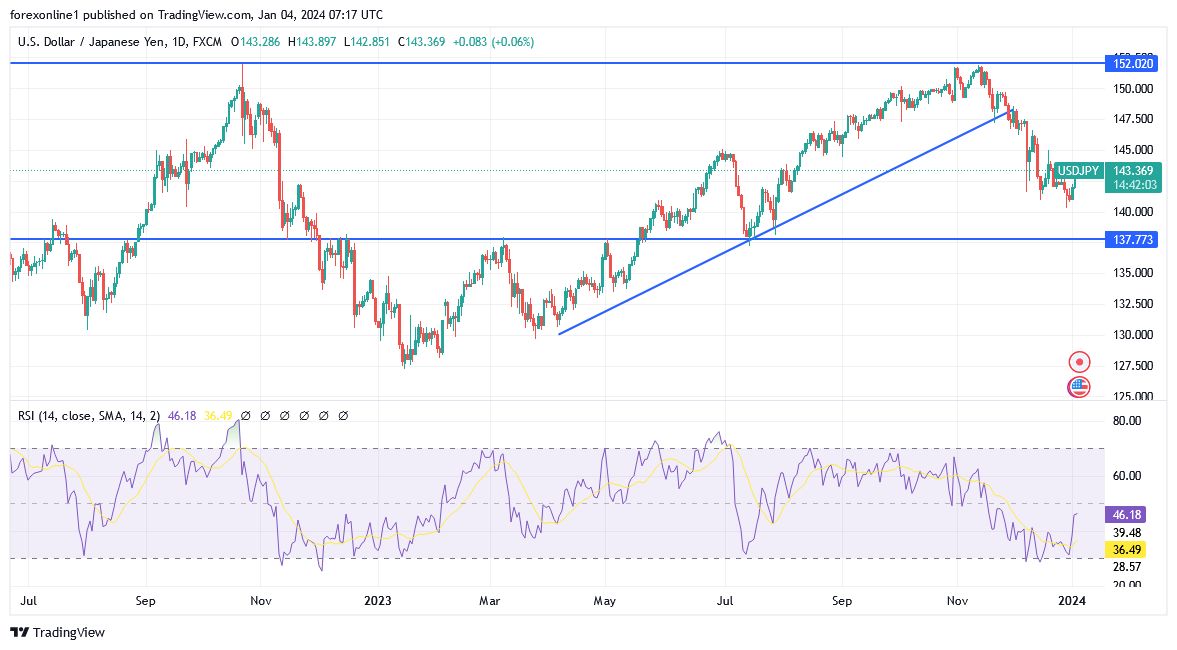For three consecutive trading sessions, The USD/JPY exchange rate has been on an upward trend reaching the resistance level of 143.89 and stabilizing around it at the time of writing. This is a rebound from the losses at the end of 2023, which saw the pair hit the lowest level in five months at 140.25. recently, the US dollar has gained strength against other major currencies amid renewed signals from the US Federal Reserve about the future of US interest rates.

Last month, Federal Reserve policymakers concluded that inflationary pressures are easing, and the Labor market is slowing. In response, officials chose to leave the key US interest rate unchanged for the third time in a row, and indicated that they expect to cut interest rates three times in 2024. Moreover, according to the minutes of their December 12-13 meeting released yesterday, bank officials indicated The US Federal Reserve said in their interest rate forecasts that a low benchmark interest rate “will be appropriate by the end of 2024” given “clear progress” towards taming inflation.
But at the same time, they “stressed the importance” of remaining vigilant and keeping interest rates high “until inflation moves clearly sustainably lower” toward their 2% target. Although Fed Chairman Jerome Powell indicated in a post-meeting press conference that the Fed was likely finished raising interest rates, the minutes show that Fed officials felt the economic outlook was uncertain enough that Further increases are still “possible”. Also, Powell had suggested in his press conference that Fed policymakers discussed interest rate cuts during their meeting, a statement that helped ignite the stock market rally. However, over the next few days, some other Fed officials tried to discourage investors from anticipating any imminent cuts. Yesterday's minutes did not provide any explicit reference to the discussion of interest rate cuts.
In their meeting minutes, policymakers sounded optimistic about inflation expectations. Furthermore, they point to the end of backlogs in the supply chain that have caused shortages and rising prices, lower rents that are starting to move through the economy and an increase in job seekers, making it easier for companies to fill vacancies without having to aggressively raise wages.
The US central bank began raising interest rates in March 2022 to combat the unexpected rise in consumer prices that began nearly a year ago. Since then, the Fed has raised its benchmark interest rate 11 times to a 22-year high of about 5.4%. The anti-inflation campaign has made steady progress, allowing the Federal Reserve to leave its benchmark interest rate unchanged since July. Ultimately, US consumer prices rose 3.1% in November compared to the previous year - down from a four-decade high of 9.1% in June 2022.
Widely, it was expected that higher interest rates would lead to a recession in the United States, the world's largest economy. Moreover, the economy and Labor market have proven unexpectedly resilient. US gross domestic product — the economy's total production of goods and services — grew at a strong annual rate of 4.9% in the July-September period thanks to strong consumer spending and business investment. At their meeting last month, some Fed officials noted that at the end of 2023, the economy appears to have slowed.
Meanwhile, US employers added a total of 232,000 jobs per month through November of last year. The US jobs report for December, which the government will release tomorrow, Friday, is expected to show that the US economy added 155,000 jobs last month and that unemployment rose slightly to 3.8%. obviously, this will be the 23rd consecutive month of growth below 4%, the longest such streak since the 1960s.
Recently, Hiring has slowed, and the Labor Department reported yesterday that US job openings fell in November to the lowest level since March 2021. Consequently, the Federal Reserve sees the decline in job openings as a painless way - compared to layoffs - to reduce pressure on companies to raise wages. To attract and retain workers, which may lead to higher prices. The combination of slowing inflation and a strong economy has raised hopes that the Fed can engineer a so-called soft landing, that is, slowing economic activity enough to tame inflation without causing a recession.
Top Forex Brokers
USD/JPY Technical Analysis and Expectations Today:
According to the performance on the daily chart above, the price of the US dollar against the Japanese yen “USD/JPY” is trying to form a base for an upward channel. Technically, this channel may strengthen if the bulls move in the currency pair towards the resistance levels of 145.20 and 147.00, respectively. On the other hand, over the same period, the support level of 141.85 will be important for bears to complete the broader downward trend. Finally, considering that the future of the Japanese yen in the coming months will depend on the policy of the Central Bank of Japan, which has taken a tightening tone recently.
Ready to trade our daily Forex forecast? Here’s a list of some of the best regulated forex brokers to check out.

